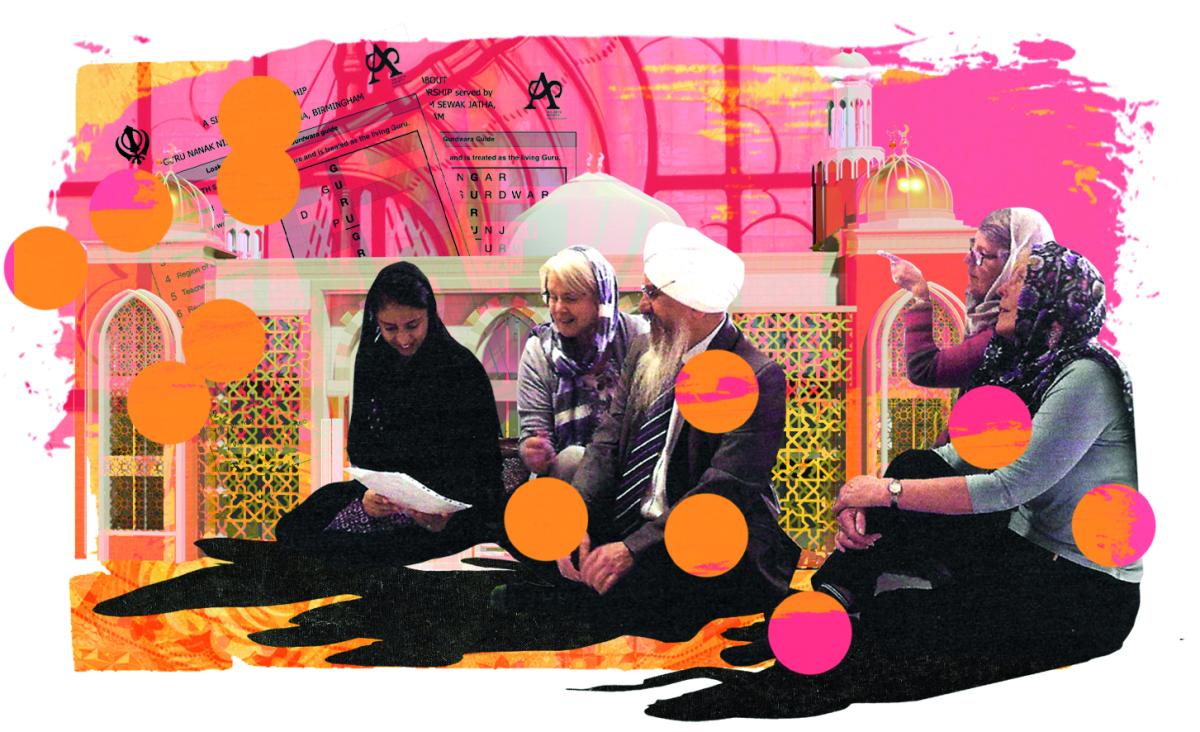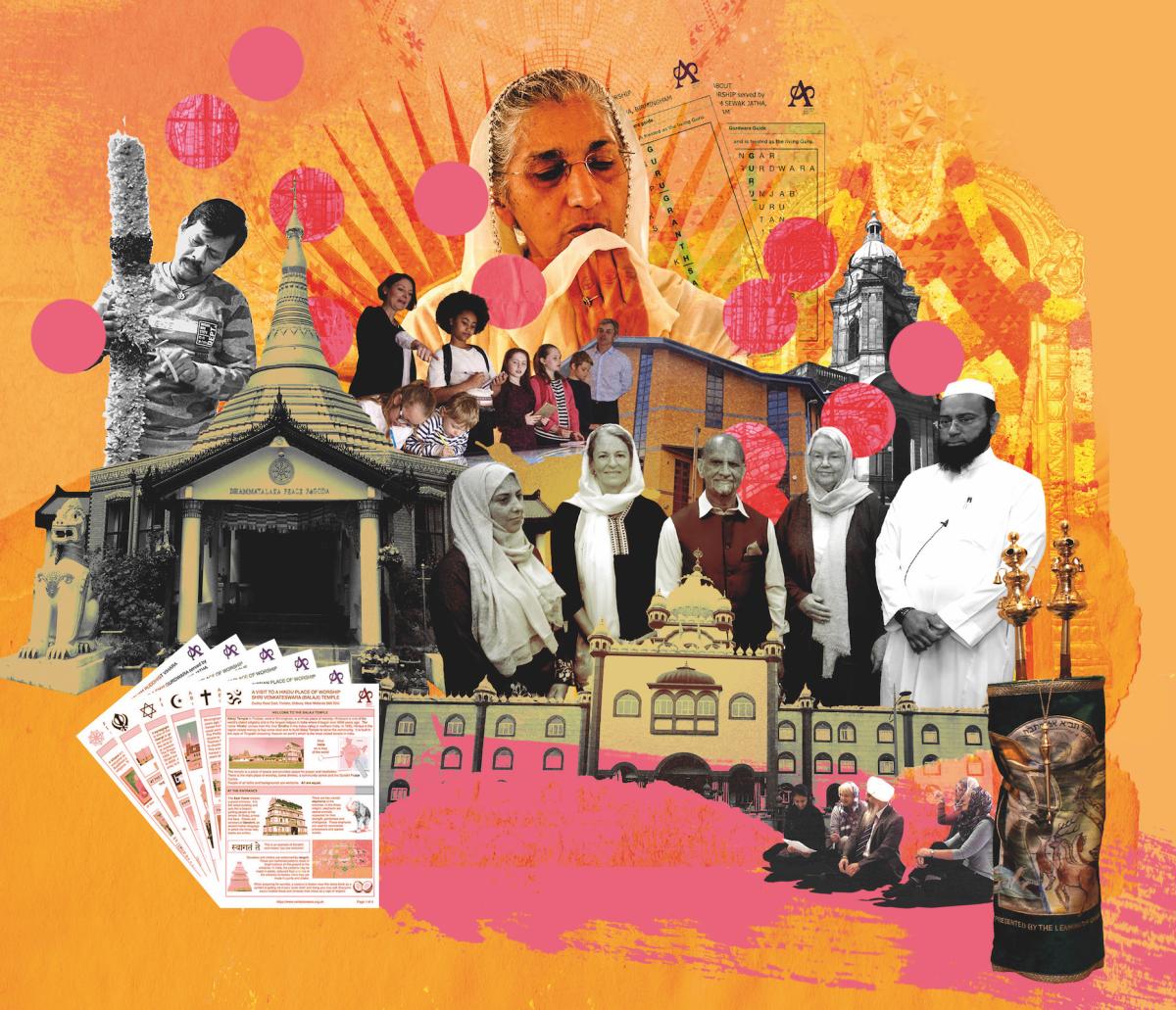This wonderful Cornish workshop and museum is dedicated to the legacy of studio pottery trailblazer Bernard Leach
Reaching Out
Reaching Out
10 Aug 2022
The Arts Society Birmingham’s faith project is a true expression of localism at work, showing – reveals Caroline Wheater – how an Arts Society initiative can have a powerfully positive effect on community

Illustration by Eleanor Shakespeare
As Britain’s second city, Birmingham is a place steeped in history and culture. Its people are multi-ethnic and multifaith, representing major world religions from Christianity and Judaism to the Muslim, Hindu, Sikh and Buddhist faiths. Across the city, places of worship are sacred storehouses of religious art and objects that reflect this dimension of our lives. At St Philip’s Cathedral, for example, Sir Edward Burne-Jones’s stained-glass windows tell Christ’s story, while at the Hindu Balaji Temple the brave and wise Ganesh sits in his shrine, bringing luck to those who pray to him.
Over at Birmingham Buddhist Vihara, a golden-roofed pagoda flanked by protective lions signifies a place of peace and meditation. With such riches to see, every year 100,000 schoolchildren visit Birmingham’s principal places of worship as part of the religious education curriculum, travelling by the busload from as far away as Pembrokeshire.
MAKING A START
In 2016, The Arts Society Chief Executive, Florian Schweizer, thought it could be beneficial to extend the successful Church Trails volunteers’ activity to include other faith institutions, creating a Birmingham- centred learning resource for schoolchildren aged eight to 13. ‘Projects like this are ideal to unlock the arts and culture for new audiences; they are also fun initiatives for volunteers to be involved with,’ he explains.
His vision for the Birmingham Faith Visits project needed a champion. Enter retired teacher Liz Dancey, who was a member of both the previous national Church Recorders and the Church Trails teams. ‘I live in the centre of Birmingham and my close neighbours are Jewish, Sikh, Muslim, Progressive and Orthodox Jews, Hindus, Buddhists, Christian and those of no religion,’ she says, ‘so the idea had real appeal for me.’
Through Liz’s contacts in the city, she arranged for Florian and June Graveson (then Head of Trails of Discovery), to meet Birmingham faith leaders to discuss whether the project was viable. The answer was ‘yes’. ‘Close collaboration is key and they became our supporters club,’ says Liz, of leaders such as Dr Bhai Sahib Bhai Mohinder Singh, one of the most senior Sikh leaders in the world, from the Sikh gurdwara in Handsworth, Rabbi Yossi Jacobs, now chair of Birmingham Faith Leaders, and Maqbool Ahmed, chairman of Birmingham Central Mosque Trustees.
‘COLLABORATION WITH OTHER PLACES OF WORSHIP FOLLOWED. THE TEAM GOT TO KNOW FAITH LEADERS AND GUIDES AS PEOPLE AND FRIENDS’
A core team from the West Midlands Arts Societies was formed, which included photographer Piers Wolf and Sheila Williams. Their observations of school visits suggested that, in spite of careful planning by schools and places of worship, the excitement of the visit was, for many children, dominated by the bus journey and food served at the sites of faith.
The actual place and its treasures, such as the glittering golden dome inside the Sikh gurdwara, and the mantle for the Torah Scroll at the Progressive synagogue, were getting less attention. ‘We wanted to tell the story of the building, the images and the symbols of sacred places that encourage pupils to be more reflective. Our hope was that they would come to notice similarities between faiths – the use of candles, bells and gongs, and flowers, for example – and to celebrate difference.’ Discussions with teachers confirmed that they lacked confidence and were hesitant of saying the wrong things. A resource was needed that would help them to feel more comfortable on such visits.

GROWING MOMENTUM
Work began and, by 2017, an illustrated guide for the Sikh gurdwara had been completed and successfully piloted. The project was adopted and sponsored by the West Midlands Societies (17 in all) led by Roly Trevor-Jones (now a Trustee of The Arts Society) and Rob Hubbleday, Chair of the Area Support Team for the West Midlands. Collaboration with other places of worship followed.
The team got to know faith leaders and guides as people and friends. ‘We listened and responded sensitively, building trust,’ says Liz. ‘For sustainability, we had to make sure that the places of worship felt they had ownership.’ By early 2020, three highly visual illustrated guides – each divided into the story of the building, the imagery and symbols of sacred spaces, and how religious belief is lived out in the community – were ready. Buzzy quizzes were added and activities designed to help consolidate the visit.
In March 2020 the world changed with the Covid pandemic. Visits stopped and the team had to find an innovative way of filling the gap. Liz turned to religious education charity Westhill Endowment for a grant to create virtual online tours for each place of worship, using existing material purchased from the Birmingham Faith Encounter Programme. Westhill trustee Julie Grove could see the potential from the outset: ‘We were taken by the idea and scope of the project. As a professional religious educator, I was particularly pleased to see something bringing the diversity of the city to a wider audience. We love projects that bring people together and enable them to understand each other better.’
Paul Davies, a Royal Television Society award-winning producer, was commissioned to craft three short films for each of five of the places of worship. These are now available to view on The Arts Society Birmingham’s site, and they bring the subject alive. The sixth set of films, for the Buddhist vihara, was being made this spring, thanks to another grant from Westhill. The set of six illustrated guides were completed during lockdown, with over 80 people contributing to the project. Some 19,000 copies were printed to distribute among the places of worship – at around 6p a copy, it costs just £2 to supply a class of 30.
POWERFUL RESULTS
Teachers have embraced the new resources, which fulfil the criteria established by Westhill and the faith leaders by being free to schools. Toni Woodward, subject leader for religious studies at King Edward VI Camp Hill School for Girls in Birmingham, comments: ‘The short video clips enable pupils to hear the voices of religious people explaining key beliefs, symbols, artefacts and buildings where they worship, which is invaluable for an RE teacher.’ While Arifa Ravat, RE lead at Hillary Primary School in Walsall, says: ‘These guides are both educational and inspiring. They provide a snapshot of the core themes and aspects of religious life in the ethnically diverse and culturally rich society that we live in.’
Rob Hubbleday, whose West Midlands Area Support Team paid for the initial print run, is delighted with the progress: ‘It’s been a way of opening people’s eyes to the potential of our area, with the heritage and culture of diverse sites such as a Sikh gurdwara every bit as interesting as an Anglican cathedral.
‘REACHING OUT IS A CORE PRINCIPLE OF THE ARTS SOCIETY, AND THIS PROJECT SHOWS OTHER SOCIETIES WHAT KIND OF PROJECTS CAN BE DONE’
As Arts Society volunteers, we hope we brought an attention to detail and the ability to record information precisely, and, being mostly retired, time to devote to the project. Reaching out is a core principle of The Arts Society, and this project shows other Societies what kind of projects can be done, and to free themselves up a bit in what they choose to do.’
For Chrissie Twigg, the then Chair of The Arts Society Birmingham at the time of the instigation of the initiative, the benefits of this ‘breakthrough project’ are multiple. ‘One of the conundrums for The Arts Society has been how to connect successfully with diverse audiences. This project has opened channels locally by raising awareness of The Arts Society in this multicultural city, widening our reach to include teachers and belief communities.
From the Balaji Temple, we have recruited new Members to our Society who are now actively involved. Our Members are also now helping to develop arts-related follow-up activities. And those involved with the project through the creative arts have felt included in a wider spiritual world of awe and wonder. Community activities such as this aid inclusion and provide fellowship for those involved.
Finally, as a local Society, we hope to foster and maintain relations with our new friends from the many religious groups, and hope that more will join us. The foundations we are laying today will help ensure the survival of The Arts Society for the future.’ For leading figure Liz Dancey, the project has had a profound effect
on a personal level: ‘It has enriched my life and changed it forever,’ she explains. And it is clear it is doing the same for others – especially for schoolchildren, offering them an important opportunity to deepen an understanding of diversity, while learning about the history, imagery and glorious artefacts of six of the city’s places of worship.
FIND OUT MORE
• This summer sees the national roll-out of the resources, with Societies encouraged to get in touch with local schools about what’s on offer via the Birmingham Faith Visits project, especially online. See birmingham-faith-visits.theartssociety.org
• As a Society, who would you like to reach out to or work with in your community? To find out more about getting a volunteering project started, email volunteering@theartssociety.org
About the Author
Caroline Wheater
Caroline Wheater is a writer and editor based in Kent
Article Tags
JOIN OUR MAILING LIST
Become an instant expert!
Find out more about the arts by becoming a Supporter of The Arts Society.
For just £20 a year you will receive invitations to exclusive member events and courses, special offers and concessions, our regular newsletter and our beautiful arts magazine, full of news, views, events and artist profiles.
FIND YOUR NEAREST SOCIETY
MORE FEATURES
Ever wanted to write a crime novel? As Britain’s annual crime writing festival opens, we uncover some top leads
It’s just 10 days until the Summer Olympic Games open in Paris. To mark the moment, Simon Inglis reveals how art and design play a key part in this, the world’s most spectacular multi-sport competition



